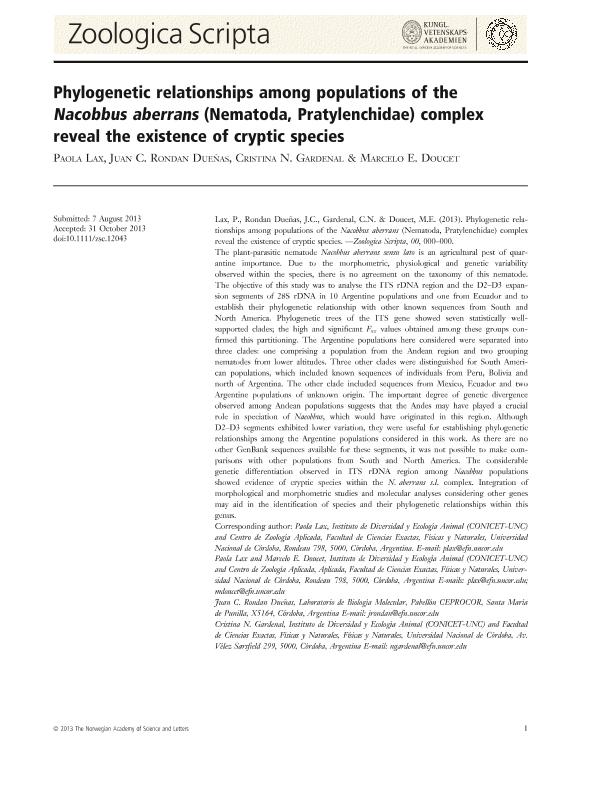Mostrar el registro sencillo del ítem
dc.contributor.author
Lax, Paola

dc.contributor.author
Rondan Dueñas, Juan

dc.contributor.author
Gardenal, Cristina Noemi

dc.contributor.author
Doucet, Marcelo Edmundo

dc.date.available
2018-01-04T20:49:47Z
dc.date.issued
2013-12
dc.identifier.citation
Doucet, Marcelo Edmundo; Gardenal, Cristina Noemi; Rondan Dueñas, Juan; Lax, Paola; Phylogenetic relationships among populations of the Nacobbus aberrans (Nematoda, Pratylenchidae) complex reveal the existence of cryptic species; Wiley; Zoologica Scripta; 43; 2; 12-2013; 184-192
dc.identifier.issn
0300-3256
dc.identifier.uri
http://hdl.handle.net/11336/32369
dc.description.abstract
The plant-parasitic nematode Nacobbus aberrans sensu lato is an agricultural pest of quarantine importance. Due to the morphometric, physiological and genetic variability observed within the species, there is no agreement on the taxonomy of this nematode. The objective of this study was to analyse the ITS rDNA region and the D2–D3 expansion segments of 28S rDNA in 10 Argentine populations and one from Ecuador and to establish their phylogenetic relationship with other known sequences from South and North America. Phylogenetic trees of the ITS gene showed seven statistically well-supported clades; the high and significant Fst values obtained among these groups confirmed this partitioning. The Argentine populations here considered were separated into three clades: one comprising a population from the Andean region and two grouping nematodes from lower altitudes. Three other clades were distinguished for South American populations, which included known sequences of individuals from Peru, Bolivia and north of Argentina. The other clade included sequences from Mexico, Ecuador and two Argentine populations of unknown origin. The important degree of genetic divergence observed among Andean populations suggests that the Andes may have played a crucial role in speciation of Nacobbus, which would have originated in this region. Although D2–D3 segments exhibited lower variation, they were useful for establishing phylogenetic relationships among the Argentine populations considered in this work. As there are no other GenBank sequences available for these segments, it was not possible to make comparisons with other populations from South and North America. The considerable genetic differentiation observed in ITS rDNA region among Nacobbus populations showed evidence of cryptic species within the N. aberrans s.l. complex. Integration of morphological and morphometric studies and molecular analyses considering other genes may aid in the identification of species and their phylogenetic relationships within this genus.
dc.format
application/pdf
dc.language.iso
eng
dc.publisher
Wiley

dc.rights
info:eu-repo/semantics/openAccess
dc.rights.uri
https://creativecommons.org/licenses/by-nc-sa/2.5/ar/
dc.subject
Cryptic Species
dc.subject
D2-D3 Expansion Segments
dc.subject
False Root-Knot Nematode
dc.subject
Its Region
dc.subject
Nacobbus
dc.subject
Plant-Parasitic Nematode.
dc.subject.classification
Otras Ciencias Biológicas

dc.subject.classification
Ciencias Biológicas

dc.subject.classification
CIENCIAS NATURALES Y EXACTAS

dc.title
Phylogenetic relationships among populations of the Nacobbus aberrans (Nematoda, Pratylenchidae) complex reveal the existence of cryptic species
dc.type
info:eu-repo/semantics/article
dc.type
info:ar-repo/semantics/artículo
dc.type
info:eu-repo/semantics/publishedVersion
dc.date.updated
2018-01-03T20:58:32Z
dc.journal.volume
43
dc.journal.number
2
dc.journal.pagination
184-192
dc.journal.pais
Estados Unidos

dc.journal.ciudad
Hoboken
dc.description.fil
Fil: Lax, Paola. Consejo Nacional de Investigaciones Científicas y Técnicas. Centro Científico Tecnológico Conicet - Córdoba. Instituto de Diversidad y Ecología Animal. Universidad Nacional de Córdoba. Facultad de Ciencias Exactas Físicas y Naturales. Instituto de Diversidad y Ecología Animal; Argentina
dc.description.fil
Fil: Rondan Dueñas, Juan. Provincia de Córdoba. Ministerio de Ciencia y Técnica. Centro de Excelencia En Productos y Procesos de Córdoba; Argentina. Consejo Nacional de Investigaciones Científicas y Técnicas; Argentina
dc.description.fil
Fil: Gardenal, Cristina Noemi. Consejo Nacional de Investigaciones Científicas y Técnicas. Centro Científico Tecnológico Conicet - Córdoba. Instituto de Diversidad y Ecología Animal. Universidad Nacional de Córdoba. Facultad de Ciencias Exactas Físicas y Naturales. Instituto de Diversidad y Ecología Animal; Argentina
dc.description.fil
Fil: Doucet, Marcelo Edmundo. Consejo Nacional de Investigaciones Científicas y Técnicas. Centro Científico Tecnológico Conicet - Córdoba. Instituto de Diversidad y Ecología Animal. Universidad Nacional de Córdoba. Facultad de Ciencias Exactas Físicas y Naturales. Instituto de Diversidad y Ecología Animal; Argentina
dc.journal.title
Zoologica Scripta

dc.relation.alternativeid
info:eu-repo/semantics/altIdentifier/doi/http://dx.doi.org/10.1111/zsc.12043
dc.relation.alternativeid
info:eu-repo/semantics/altIdentifier/url/http://onlinelibrary.wiley.com/doi/10.1111/zsc.12043/abstract
Archivos asociados
